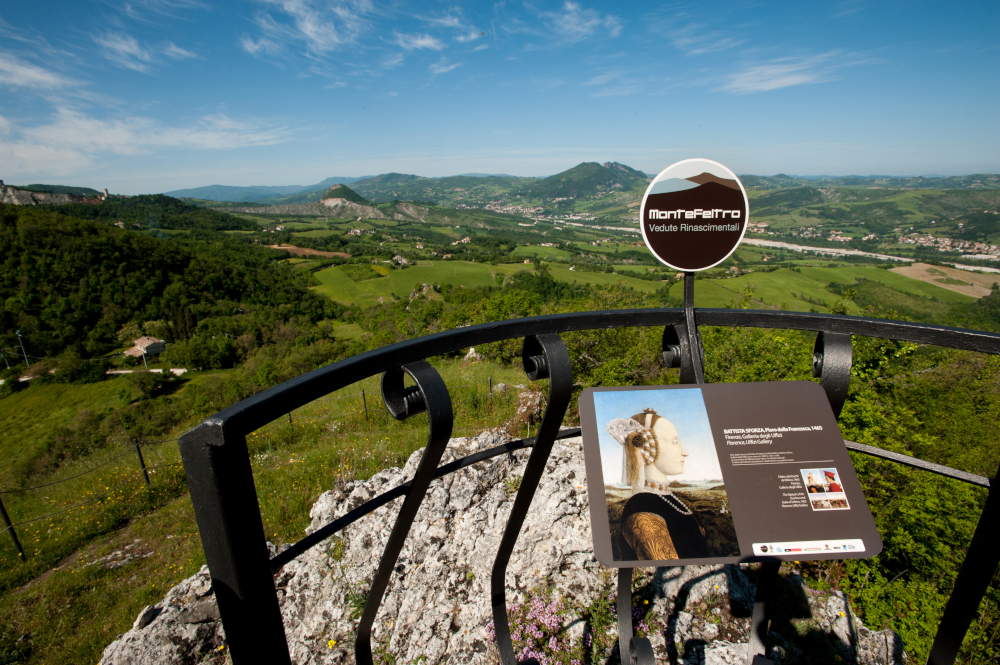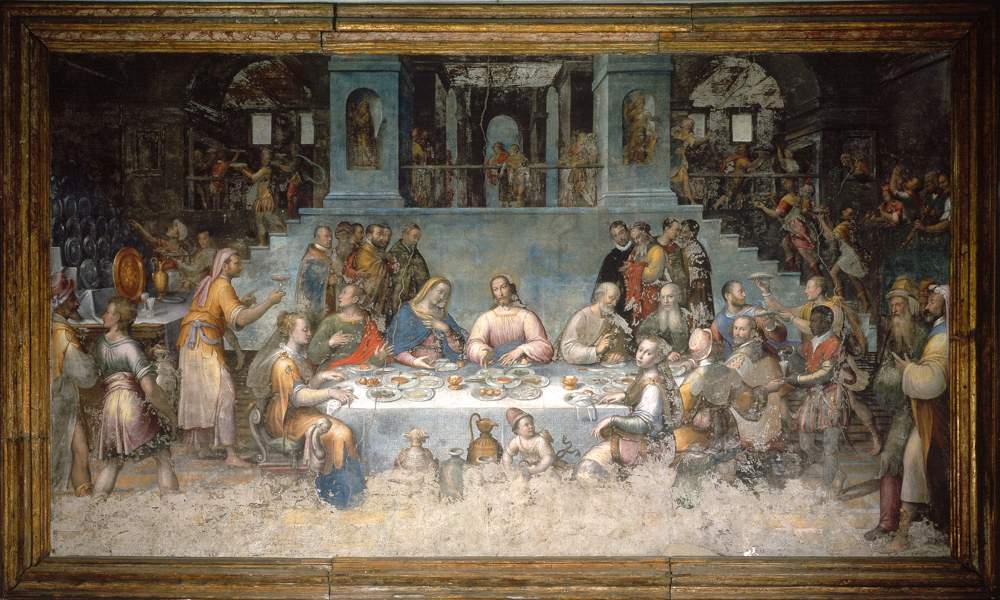We continue the series of articles that have led you to discover Renaissance Romagna with two more itineraries promoted by Visit Romagna, aimed at getting to know places among art, nature and culture in the provinces and municipalities of Romagna linked to this extraordinary era, which saw great artists active in the area leave precious evidence of their passage.
A prestigious example of this is Piero della Francesca, who at the court of Marquis Leonello d’Este, half-brother of Borso d’Este, worked in 1448-49 at the Castle of San Michele and in the church of Sant’Andrea, to create frescoes that were unfortunately lost. In Rimini, on the other hand, where the artist arrived in 1451 called by Sigismondo Pandolfo Malatesta, he worked inside the architectural masterpiece that is the Malatesta Temple (read our dedicated article here ). And here he painted there the fresco depicting Sigismondo Malatesta kneeling before his patron saint Sigismondo, the first fully Renaissance pictorial work, in a context still linked to courtly Gothic, and the only dated work by Piero della Francesca in the Emilia-Romagna territory, which therefore testifies to the period linked to the Malatesta court.
The exterior appearance of the Malatesta Temple, however, is due to Leon Battista Alberti, who, starting in 1453, began to arrange the exterior of the ancient church of San Francesco, a Gothic basilica with a single nave and side chapels: the commission had been entrusted to him by Sigismondo Malatesta, lord of Rimini and Fano since 1432. The great architect designed an innovative temple: he used the typical structure of theRoman triumphal arch for the façade, drawing inspiration from the Arch of Augustus in Rimini, and, as in an ancient temple, he also inserted a frieze with the inscription SIGISMUNDUS PANDULFUS MALATESTA PANDVLFI F V FECIT ANNO GRATIAE MCCCCL, or “Sigismondo Pandolfo Malatesta, son of Pandolfo, realized by vow in the year of grace 1450.” According to Leon Battista Alberti’s design, the monument was to be completed with the inclusion of a majestic rotunda crowned by a dome taken from the Pantheon in Rome, but the project remained unfinished with Sigismondo Malatesta’s death in 1468, although work had already stopped at the time of the clashes with Pius II. A medal by Matteo de’ Pasti, Alberti’s collaborator in Rimini, on which the complete design of the Malatesta Temple with the planned dome can be seen, is preserved at the Museum of the City of Rimini.
In addition to Rimini, Leon Battista Alberti was also linked to Ferrara, where he produced some of his treatises, such as Theogenius and De equo animante, both dedicated to Leonello d’Este, prince and lord of the city between 1441 and 1450. The famous architect and intellectual would probably also be linked to the bell tower of Ferrara Cathedral, built starting in 1412 and finished on several occasions between 1451 and 1487. According to Francesco Ceccarelli’s recent investigations, not only is Alberti’s attribution of the Ferrara bell tower reconsidered (the same marbles were also used for the Malatesta Temple), but the early chronology (c. 1454) suggests its role as a prototype.
Intent of the itinerary Leon Battista Alberti and Piero della Francesca. The Rebirth of the Arts between Ferrara and Rimini, which takes place between the cities of Rimini and Ferrara, is precisely to let visitors discover the rich historical-artistic and intellectual heritage that Piero della Francesca and Leon Battista Alberti left us when they were active at the Este and Malatesta courts.
Through the Montefeltro Art Views project, the result of the collaboration between GAL Montefeltro Sviluppo, the Emilia-Romagna Region and landscape architect Carlo Leonardi, it is also possible in Montefeltro to rediscover the exact landscapes and views that served as the backdrop for famous works such as The Baptism of Christ, The Resurrection, The Nativity, The Portrait of Battista Sforza, St. Jerome and a Devotee. Landscapes that until 2007 were believed to be imaginary, until some scholars felt they had identified them. We give a few examples: Montecopiolo-Mount Palazzolo is said to have inspired Piero della Francesca for his Nativity, and also in Montecopiolo, in the locality of Pugliano, one would find instead the landscape that inspired the Resurrection. In Sant’Agata Feltria, in the locality of Petrella Guidi, the background of the Baptism of Christ; in San Leo that of Saint Jerome and a devotee; and in Poggio Torriana, in the locality of Montebello, that of the Portrait of Battista Sforza.



Instead, the protagonists of the itinerary The school of art in Ravenna between the 15th and 16th centuries: the pictorial masterpieces of Francesco Zaganelli and Luca Longhi, which leads into Renaissance Ravenna, are Francesco Zaganelli (Cotignola, 1450/1460 - Ravenna, 1532) and Luca Longhi (Ravenna, 1507 - 1580). The former, influenced by Ferrarese Renaissance art, especially by Ercole de’ Roberti, produced works in Ravenna starting in 1513, many of which are now housed in the MAR Museo d’Arte della Città, and between 1518 and 1532 he executed many works for Ravenna churches: in the church of San Nicolò are The Crib and Saints Catherine and Sebastian; in the church of Sant’Agata the Crucifixion and the Mourners; in that of San Romualdo the Resurrection of Lazarus. The second, on the other hand, brought Mannerism characterized by a refined but extravagant style and brilliant colors to his hometown through his masterpieces. Initially his painting tends toward graceful and gentle forms until his artistic language is influenced by the manner of the late 16th century. His masterpieces can be admired at the Ravenna MAR, but also in the city’s churches, such as in Santa Maria in Porto, Santa Barbara, San Francesco, Sant’Agata, Santa Maria Maggiore, San Giovanni Battista and the Duomo: works that the painter completed in close contact with his children Francesco and Barbara, painters equally talented as their father. And again, in the Archbishop’s Palace and the Classense Library, where the painting on the wall backdrop of the refectory depicting the Marriage at Cana is preserved, in which Ravenna of 1579 can be recognized in the background.
Longhi also executed the two panels depicting theAdoration of the Shepherds and Christ Supported by Angels for the Abbot of Classe, now housed in the MAR Art Museum of the city of Ravenna. For the Basilica of San Vitale, on the other hand, he completed in 1559 the panel with the Martyrdom of Saint Ursicino, and between 1579-1580 he painted in San Domenico the canvas with theInvention of the Cross.
They are testimonies of Renaissance Ravenna (the Renaissance invaded the city with the arrival of the Venetians who conquered it in 1441, and it was from this time that Ravenna began to endow itself with squares, monumental complexes and churches that reflected the artistic tastes and canons of classical beauty proper to the Renaissance) the Rocca di Brancaleone, the Piazza del Popolo, whose plan followed the dictates of Leon Battista Alberti, and there is to emphasize how numerous churches in the city, such as the church of San Francesco, the church of San Giovanni Evangelista, Sant’Apollinare Nuovo and even the San Vitale complex, were enriched in this era with porticoes, chapels and decorations that made direct reference to Renaissance canons.
Works by Luca Longhi are also found in Forlimpopoli: two altarpieces on canvas that belong to the painter’s early phase are preserved in the Collegiate Church of San Ruffillo. These are the Madonna Enthroned with Child and Saints Ruffillo and Anthony of Padua placed on the high altar and the Madonna Enthroned with Child and Saints Valeriano and Lucia placed in the apse; both were commissioned in the early 16th century by the lord of Forlimpopoli, Antonello Zampeschi. To his son Francesco, on the other hand, are attributed an altarpiece depicting theImmaculate Conception in the 17th-century Church of the Carmine and the frescoes in the palatine chapel on the main floor of the Ordelaffa Fortress.
For more information on itineraries dedicated to Renaissance Romagna, visit the Visit Romagna website.


 |
| Renaissance Romagna: Piero della Francesca and Leon Battista Alberti in Rimini and the Ravenna Renaissance. |
Warning: the translation into English of the original Italian article was created using automatic tools. We undertake to review all articles, but we do not guarantee the total absence of inaccuracies in the translation due to the program. You can find the original by clicking on the ITA button. If you find any mistake,please contact us.